The Rubin Museum features pieces of art from 32 different artists related to Buddhism. This stems from various cultures, including those of Central Asia, India, and the Himalayas. The four works shown below all portray the difference between past and present culture and technology.
The Windhorse
The most notable piece of art at the museum was the hanging cloth in the middle of the staircase. This piece is almost 6 stories tall and is composed solely of a variety of different cloths, differing in color and shape. The location of this work in the stairwell is symbolic of the way people go from Earth to heaven, which is represented by going up the stairs.
At first, I noticed the color scheme and the cloth structure, but I didn’t realize until I got closer that each cloth had writing on it. The writing consisted of various discarded prayers that were put together to form this immense work.
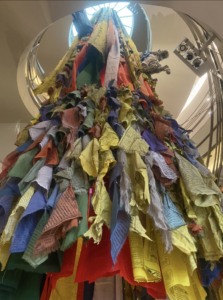
There were horses made of the same fabric protruding on each side for each layer. These five wind horses were adopted by the Buddhists, and they represent fortune and wellbeing, especially in ones’ journey to their afterlife. This part really intrigued me.
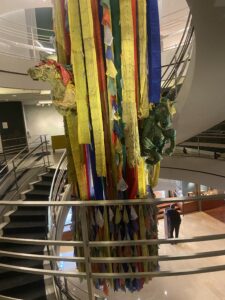
Although this piece wasn’t a typical painting or statue, I believe it was one of the best pieces of art I have seen here. Its immense size and detail made this the most significant work in the exhibit.
The Uber Rat
This piece of art showcases past culture integrated with todays technology. The artist, Shushank Shrestha illustrated a divine being, represented by the three eyes, needing modern conveniences. The Uber Rat is supposed to be a mix of a rat and a car, which relates to the hybrid technology in todays society. 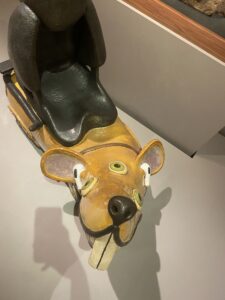
The three eyes on the rat stood out the most, along with the giant teeth. The artist was inspired by the uber drivers in New York City, so he incorporated the air pods. In addition to this, the overall appearance of the rat looks much like a rat you would see in the city.
The Red Strings
When I first walked into the museum, I noticed red strings connected to the railing. On the first floor, there was what I thought was a mannequin in the middle of the red strings posing. When I went downstairs, I noticed she started moving. I was disturbed to see that she was being used as art. 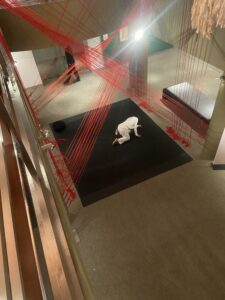
This exhibit was the only part of the tour that I didn’t appreciate. I found it hard to interpret and connect to.
Monkey Mask
The monkey mask shown below was used in monastic festival dances to teach karma through the Lord of Death. The monkey is said to count out white and black stones, which represents an individual’s good and bad deeds. The peg on the top of the mask was used to help the wearer conceal their head and become one with the monkey. I thought the peg stood out the most, especially because of its large size in relation to the rest of the mask.
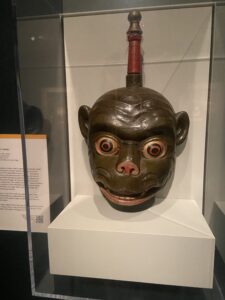
Overall, I believe the art was well crafted and really symbolized the Tibetan culture. I personally couldn’t connect to the art, but I did appreciate the time and detail put in most of the pieces.



